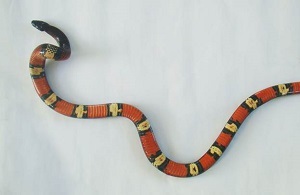Co-authored with George Lewis
It looks like a deadly coral snake, but it isn't. Still, officials at the Galápagos National Park are highly concerned about the discovery of what appears to be a scarlet king snake, run over by a motorist near the town of Santa Rosa in the highlands of Santa Cruz Island. There are four varieties of terrestrial snakes native to the Galápagos Islands and this is not one of them.

Photo by Galapagos National Park
According to a statement from the National Park, the snake was turned over to authorities on Sunday where it was identified by herpetologists at the Charles Darwin Foundation.
Park officials, constantly on the lookout for invasive plants and animals, ordered an intensive search in a one kilometer area around the spot where the snake was discovered to determine if there are others on Santa Cruz Island. The king snake is native to the eastern and southeastern United States and its importation into the Galápagos is illegal. According to the government statement, this would be the first case of a snake being brought into the islands.
Marilyn Cruz, Executive Director of the Agency for Regulation and control of Biosecurity for Galapagos said, "Our quarantine systems work efficiently only if citizens live in a responsible manner in this special ecosystem."
And if you're concerned about how to tell a king snake from the deadly coral snake, there's an old rhyme about the coloring of the snakes that people use to jog their memories: "Red touch yellow, kill a fellow. Red touch black, friend of Jack."
The snake found on Santa Cruz has red touching black on its skin -- meaning it's non-poisonous. But officials on the island don't regard it as any sort of friend.
This was originally published on Galapagos Digital.